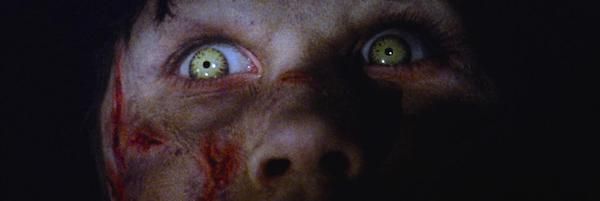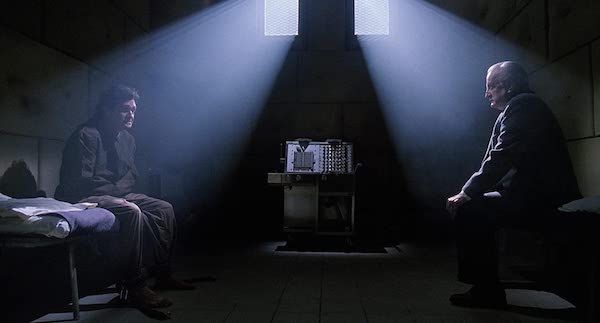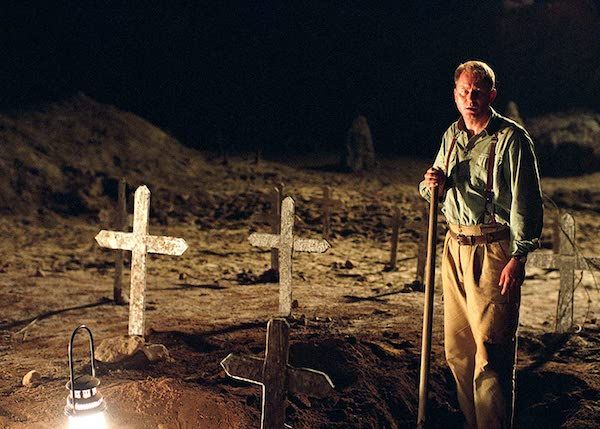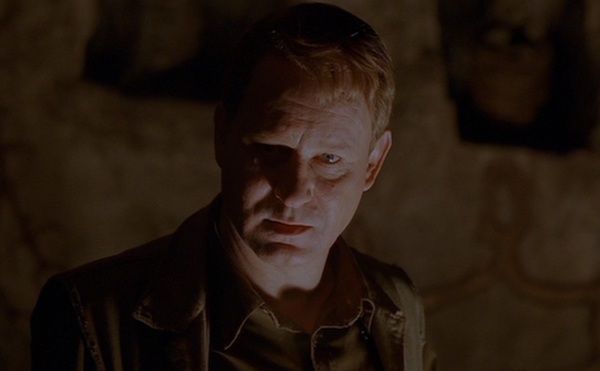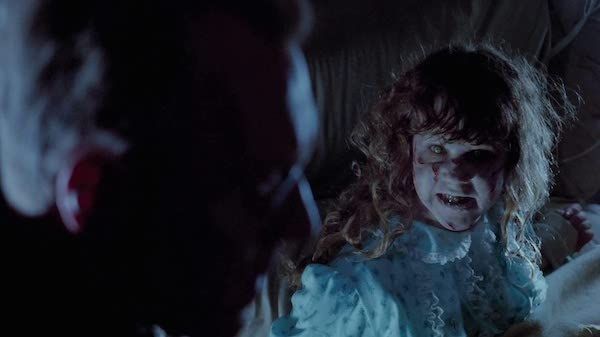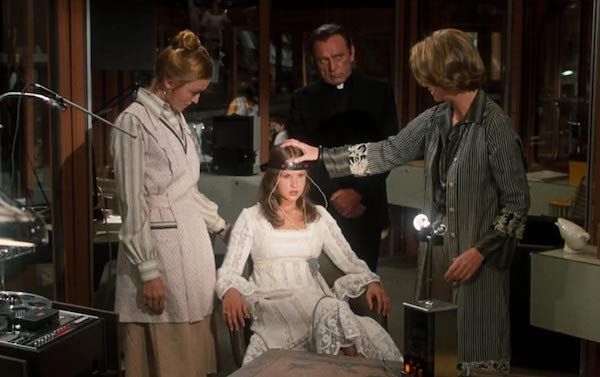When it comes to horror franchises, there's none quite like The Exorcist. With five films total, this franchise has carved out an interesting niche for itself within the horror genre. It all begins with 1973's The Exorcist, which was adapted by author William Peter Blatty from his own novel and directed by William Friedkin. The Exorcist was a critical and commercial hit, holding the title of the highest-grossing horror movie until the release of 2017's IT. It also went on to earn 10 Oscar nominations and winning two (Best Adapted Screenplay and Best Sound Mixing).
The story begins with the possession of a 12-year-old girl in Georgetown, Washington, D.C. and a priest whose wavering faith in reaffirmed with this horrific event. It's ultimately an unsettling, introspective film on what it means to have faith, where evil originates, and how it touches all our lives. Given the weighty, horror-filled material, it's no wonder The Exorcist has spawned sequels. There's plenty to chew on, so why not chew? But what has resulted over these last decades is a disparate franchise marked by valiant efforts to hone in on something as effective as the original movie. ome succeed while others fail miserably. Some manage to make the examination of good vs. evil, faith vs. science, the psychological effects of what is seen vs. what is unseen a compelling thing to watch. Some just don't. Such is the way of franchises — and this is especially true in the case of The Exorcist and its four sequels.
So, on the occasion of the 30th anniversary of 1990's The Exorcist III, I figured it was about time we rank these suckers and see how the franchise holds up. You may want to strap in and try not to puke pea soup as you read this ranking because it flies in the face of dang near every other ranking out there. But trust me, I have my reasons.
Allie Gemmill is the Weekend Contributing Editor for Collider. You can follow them on Twitter @_matineeidle.
5. The Exorcist III
Frankly, The Exorcist III is an inexcusable mess. Why has this entry remained in such good standing over the years? Sure, it boasts a pretty clever jump scare and features both Patrick Ewing and Fabio in cameo roles as angels watching over the dead in an otherworldly way station; credit where credit is due. However, not even these highlights can save a movie which is connected to the world of The Exorcist in the loosest way possible, is unintentionally hilarious, and features some of the weirdest storytelling decisions I've seen in a movie in recent memory.
The Exorcist III picks up more than a decade after the events of The Exorcist, following Detective Kinderman (now played by George C. Scott) as he tries to solve a string of murders which bear a resemblance to the methodology of the deceased Gemini Killer (Brad Dourif). Kinderman's investigation takes him to a psych ward, where the evil spirit seems to lurk, possess patients, and occasionally take the form of the late Father Karras (Jason Miller returns, making a valiant effort). Kinderman is clearly haunted by Georgetown and is now forced to re-examine his relationship to those events through this search for a killer.
It's an interesting premise, and if it were made completely unattached to the Exorcist story, it probably would be more interesting to consider. But alas, it is connected and it simply doesn't live up to any kind of standard of good execution. The Exorcist III is a tonal mess, moving between unintentional comedy, horror, and drama at such a chaotic pace it's hard to keep up. It's hard to watch Scott, a bonafide Oscar-winner at this point, try to make something of the truly bad script handed to him. (If you can explain to me why this carp speech was included in the movie and why Scott was forced to say it, I'll give you $100.) He's a good actor! This should not be happening. The same goes for the rest of the Exorcist III cast, all of whom are doing their damndest with writer/director William Peter Blatty's words. Perhaps that's the real root of the problem here: Blatty's direction leads to mystifyingly bad results. Every choice made by the director is confusing to the point it's hard to believe this is coming from the same man who won an Oscar for adapting the script for The Exorcist from his own book. There are some interesting thematic ties to The Exorcist which Blatty seems keens to explore, but his movie fumbles so badly it's hard to take this movie seriously a majority of the time.
The Exorcist III is payback for the sins of man. I'm convinced of it.
4. Exorcist: The Beginning
Of the two Exorcist prequels attempted in the mid-00s, director Renny Harlin's version, Exorcist: The Beginning, comes in second. Exorcist: The Beginning is the result of Morgan Creek Entertainment's loss of faith in the commercial viability of the version filmed by director Paul Schrader (more on that below). The studio shelved Schrader's take, hired Harlin and screenwriter Alexi Hawley to overhaul the movie Schrader had turned in, and the drastic results produced by Harlin and Co. were Exorcist: The Beginning.
Exorcist: The Beginning attempts to offer up an explanation on Father Lankester Merrin's (Stellan Skarsgård) time spent in Africa post-World War II. Both Harlin and Schrader's films focus on this but diverge in notable ways when it comes to telling Merrin's prequel story. For Harlin's version, Merrin, haunted by the events of WWII and having left the Catholic Church to pursue archaeology, somewhat begrudgingly agrees to join a dig in East Africa which isn't going according to plan. While there, Merrin discovers the location is home to a centuries-old church that houses the spirit of the demon Pazuzu (first introduced in The Exorcist). The demon eventually possesses someone close to the dig and Merrin finds himself confronted with true evil, eventually donning his robes and performing an exorcism.
Harlin's version of this Exorcist prequel undoubtedly delivers on what Morgan Creek was ostensibly looking for. The story forgoes anything too deeply intellectual, preferring to stay steeped in mood and action and unafraid to be a little sexy or subversive. It's clear Harlin was given carte blanche to do his thing — entertain without worrying about making too much sense — while re-filming Exorcist: The Beginning. However, it's very clear there is a much headier movie lurking underneath the surface (the remnants of Schrader's version) and Harlin's version is ultimately too disjointed and superficial to offer anything of value to this franchise at the time of its release in 2004.
3. Dominion: Prequel to The Exorcist
The other Exorcist prequel, director Paul Schrader's Dominion: Prequel to The Exorcist, is the superior prequel — but it's still not a terribly good movie. Dominion was shelved by Morgan Creek as the studio scrambled to turn out a prequel they felt would play well with audiences (enter Renny Harlin), with this version eventually released one year later in 2005. Written by William Wisher and Caleb Carr (the pair get "story by" credits on Harlin's film), Schrader's take on Father Lankester Merrin's (Stellan Skarsgård) life-changing mission to Easter Africa is far more contemplative than its counterpart. While neither Dominion nor Harlin's version take any great pains to stick to the Exorcist lore laid down in the first two movies — the young child exorcised by Merrin in Exorcist II is not the same child in Dominion or Exorcist: The Beginning — it certainly feels thematically and tonally aligned with the first two movies.
Skarsgård is a much better fit with Schrader's direction and the script provided by Wisher and Carr. In Dominion, Skarsgård's Merrin is still very much haunted by his time in World War II and has since left the church. However, this time around he's leading the dig which uncovers the ancient church containing the spirit of Pazuzu, thus adding some more emotional investment into the events that follow. Like Blatty's script for The Exorcist, the Wisher/Carr story is interested in the ties between human trauma and faith, and how pain of any kind can leave a person vulnerable. Merrin is marked by the grief he harbors over one particular event from the war and Schrader is actively interested in spending time digging through Merrin's past and how it affects his time in East Africa. In this way, Dominion earns its place in The Exorcist franchise.
However, Schrader and this particular horror story. don't go together as well as one might hope. While the movie succeeds in the more intellectual discussions supporting the story, Dominion is devoid of any real or effective scares. Even the exorcism in the final act is more like a stage play than anything resembling the kind of special effects-laden showdown we might expect from a horror movie in 2005. Alas, Schrader did his best, but even making the better of two prequels does mean this movie is a true success.
2. The Exorcist
I have a great fondness for The Exorcist. What's not to love? Ellen Burstyn, Linda Blair, and Jason Miller more than earn their respective Oscar nominations for Best Actress, Best Supporting Actress, and Best Supporting Actor. Similarly, Friedkin's direction of The Exorcist is skilled, with the director supporting the otherworldy and horrifying events of Reagan's possession by the ancient demon Pazuzu with compelling dramas around Father Karras' (Miller) disillusionment with his work as a priest and the MacNeils' (Burstyn, Blair) personal lives forever changed by Reagan's possession and their search for answers. In this regard, it's somewhat disappointing that The Exorcist leans more on its dramatic arcs than the horrors of possession because the special effects used to bring Reagan's possession to life are some of the most compelling in the movie.
It's clear the effort and attention to making the most frightening and realistic (for the time) on-screen possession was at the forefront of everyone's minds. The visceral effects, like the sudden appearance of breath as Reagan's room goes cold or the viscosity of her vomit, are remarkably effective. The performances from Blair, von Sydow, and Miller work well in tandem with each other, and even when the two men have to work opposite a puppet whose head is spinning full circle, you believe in it wholeheartedly.
1. Exorcist II: The Heretic
Well, well, well, looks like I'm about to shake things up and rehabilitate a movie many have derided since its release in 1977. Here's the deal: Exorcist II: The Heretic absolutely rips. People will try to tell you that Exorcist II is bad, a misfire, not as scary or well done as its predecessor. Do not, under any circumstances, listen to them. Not only has Exorcist II aged nicely since its release, but it actually succeeds in expanding the lore of The Exorcist without dragging the movie down, delivering in some really fun, surprising ways.
First, we have to address just how the cast and crew attached to Exorcist II is. Linda Blair is back as Reagan MacNeil and Kitty Winn returns, too, as Reagan's guardian Sharon Spencer. Joining them are Richard Burton, Max Von Sydow, Paul Henreid, James Earl Jones, Louise Fletcher, and Ned freakin' Beatty in a very brief role. John Boorman (Zardoz, Deliverance) directs, William Goodhart writes, and the late, great Ennio Morricone provides the score. I mean, Exorcist II just might be, pound for pound, the most creatively-stacked cast and crew of the entire franchise.
Exorcist II picks up four years after the events of The Exorcist. Reagan (Blair), now a teenager, is getting therapy after the events in Georgetown from Dr. Gene Tuskin (Fletcher) and lives in a chic New York City apartment with her guardian, Sharon (Winn). There's a chance Reagan remembers more about her possession and subsequent exorcism than she lets on, and Tuskin is curious to dig in and see what exactly Reagan is holding onto. At the same time, Father Philip Lamont (Burton) is charged by a cardinal of the church (Henreid) to find out the true cause of Father Lankester Merrin's (von Sydow) death in Georgetown. Lamont's journey leads him to Reagan, where the fates of these two people become entwined as they search for answers about the origins of the demon Pazuzu, its relationship with Merrin, and which it latched onto Reagan back in 1973.
While The Exorcist has the better horror of these top two movies, Exorcist II does a better job of balancing its scares with a more coherent exploration of the Pazuzu lore and its thematic contemplations. Exorcist II is a movie focused on the legacy of evil, the lasting effects on those it has touched, and what kind of life we can reasonably have when we move on from that evil after we've defeated it. There's so much to think about here and this movie is not afraid to dig in while also entertaining.
I want to give a big shout-out to the set design of this movie. Every set is both practical and otherworldly. The facility Tuskin works at, the rock churches of Ethiopia, Kokumo's village as a child — all of it invites the viewer's gaze and helps keep the attention focused. The futuristic technology used to bring Reagan and Lamont onto the same psychic plane is a similar stroke of genius, with the machine's flashing lights and hypnosis methodology providing for some of the more intriguing sequences. When considered in addition to the genuinely grabbing and grounded performances from the cast — Blair and Burton, especially — Exorcist II transforms into an atmospheric, arresting bit of horror cinema.

